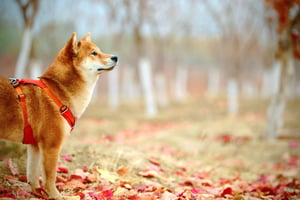Leash training a puppy can be a challenging yet rewarding experience. Knowing how old to leash...
Leash training a puppy: all you need to know
Leash training a puppy can be made into a fun learning experience for both you and your pooch. Like with most things regarding training, learning how to train a puppy does take some time, patience, positive reinforcement, and consistency.
Is it hard to leash train a puppy?
No, it is not hard to leash train a puppy, but it is time-consuming and each puppy learns at its own pace. The idea behind teaching them to walk on a leash with you is to make it enjoyable and have them think it was their idea, no dragging and no force included.
It is important to get them used to the idea of first, wearing a collar and or a harness, and making sure that they are comfortable with the whole leash training process before commencing any kind of training that involves leading. New things are very distracting for puppies, and when training the key is having and holding their attention.
Removing unnecessary distractions from the area you are going to do your training in, is ideal.
When should I start leash training my puppy?
Begin leash training your puppy as soon as you get them home, or, if you are the breeder and have the extra time to fit in, the best time to start training your puppy is anywhere from 4 weeks old.
It is important to remember, however, that little dogs have the attention span of Dory. Yes, that is right, the blue fish with the big heart yet terrible memory from “Finding Nemo.”
Puppies of this age onwards are like little sponges, they’re soaking up lots of external information and as long as you have the patience and time, the sooner you begin, the quicker they learn.
How long will it take to leash train my puppy?
It should take between 4-6 weeks as a general rule. There are a lot of variables to take into consideration though, so this is merely a guide and you should not hold high expectations. You have to factor in the time you have to spend, the consistency, the breed, the age, and the fact that every puppy learns in a different time frame.
Remember to just enjoy the journey of training your puppy without holding too many expectations.
Is it better to use a collar or harness on a puppy?
The debate of collar vs harness ultimately comes down to personal preference. Both have pros and con’s but think of it as whatever works best for each individual puppy.
Harnesses are excellent training tools for puppies that are not leash trained yet, and they offer better control and a safer way to train – depending on how you train of course.
A harness disperses pressure over a greater area of the dog's body especially when leash training your pup, therefore reducing potential strain on his body particularly the neck and back.
Harnesses are a great solution if you happen to have a little Houdini that no matter what you do, seems to wiggle out of their collar and run away.
A traditional collar that does not constrict is fine for dogs who don’t have respiratory problems and aren’t prone to taking their owner for a walk instead of the other way around. They may also be more comfortable for some dogs, especially if you plan on leaving it them on all the time.
Collars are a more comfortable option for all-day use and are preferred for use with dogs that have long hair, especially when leash training puppies with long hair. It’s no fun for the dog to have hair pulled and pinched in a harness.
A good idea is to have one of both and see which is the best option for your puppy, and there is no harm in training them to be obedient with both.
Why should I leash train my puppy?
Discipline and good behavior are just as important for our furry family members as it is for our two-legged family members.
Preventing behavioral problems from even raising the head over the hedge, rather than trying to cure them, is paramount.
Teaching your puppy to behave on a leash is important just like teaching your dog to heel appropriately, as it is vital for their safety and yours.
Dogs have an instinct to chase things, by leash training your puppy from the beginning you can avoid putting yourself in a situation that could put your four-legged friend or yourself in danger.
How do I leash train my puppy?
You can leash train your puppy by starting with these few simple steps. It is important to remember that you are introducing a lot of new things into their daily routine and that their attention span is not that long. Teaching them during their awake / playtime is an optimum time for them to learn something new.
-
Step 1: Practising inside the house in an open space, starting the training without a leash
-
Step 2: Ask your puppy to come to you, and when they do, offer a treat and make a fuss, positive reinforcement is vital.
-
Step 3: Walk away a few steps, while maintaining their attention, when they follow along, give another treat and praise them.
-
Step 4: Lather, Rinse and repeat. Continue this little exercise around the training area until they are following you around consistently.
-
Step 5: Once your puppy is happy to follow you everywhere, repeat the process with a leash attached to either their collar or harness, this enables them to get used to something new being introduced to the situation.
-
Step 6: If your puppy is pulling on the leash or harness and just wants to do what they want, it is a good idea to stand and wait for them to come back to earth. Teaching them cues such as no pressure means they can go, and pressure/command means stop, is a vital part of their training too.
My puppy is being difficult to leash train, what do I do?
It is a good idea to go back to basics if you are having difficulties leash training your puppy. Start with step one once again, and ensure you are giving them the time they deserve to be able to learn.
If you are still having trouble with your puppy and they have you scratching your head over what to do next, click over to our website at Fluffy and check out all our training content. Download our app - the first personalized dog training app.
Our app has been created in partnership with leading trainers and animal behavioral specialists. We leverage information about your dog's unique character to recommend courses and personalize your training routine.



